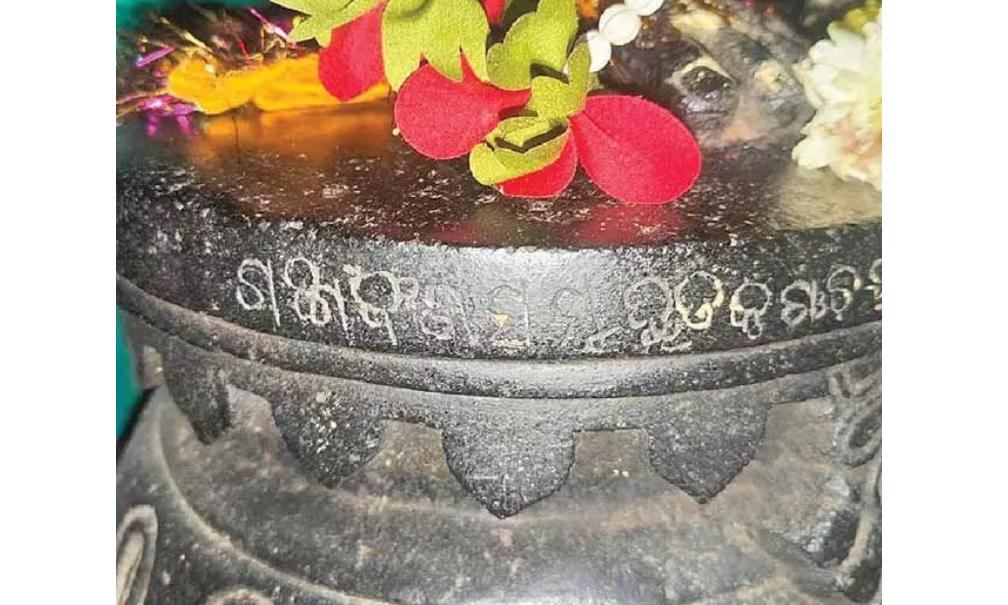Lifestyle
Eastern Ganga-Era Inscription Discovered in Tekkali, Andhra Pradesh

A significant archaeological discovery has emerged from Tekkali in the Srikakulam district of Andhra Pradesh, where an inscription dating back to the Eastern Ganga dynasty was found. The inscription, one of the oldest recorded Odia inscriptions from this period, highlights the cultural and political connections between ancient Odisha and northern Andhra Pradesh.
The inscription was located at the Krushna Chandra Matham, specifically on the lotus-feet panel of the principal deity within the temple’s sanctum. According to epigraphist Bishnu Mohan Adhikari, the text is inscribed in Sanskrit using the Odia script. It reads: “Gāṅgavansha-samudruta Kṛṣṇacandra-mahipateḥ rāgyan Nīlamanī-devyāḥ patīmēyādi-nirmāṇe.” Upon interpretation, it states that the idol was constructed under the patronage of Queen Nīlamanī Devī, the consort of King Krushna Chandra Gajapati. This ruler governed the Raghunāthpur estate, which included the areas of Nandigam and Buragam in Tekkali.
This inscription sheds light on the identity of Queen Nīlamanī Devī, who describes herself as Gāṅgavansha-samudruta, a proud descendant of the illustrious Eastern Ganga dynasty. This dynasty is known for its historical significance, having ruled Kalinga and constructed notable temples, including the Jagannātha Temple of Puri, as well as the Srikurmam, Srimukhalingam, and Varaha Nrusimha temples in the surrounding regions.
Historical Context and Significance
This recent find is the second known inscription referencing Queen Nīlamanī Devī. The first was discovered on a pillar in the Asthāna Maṇḍapa of the Varāha Lakṣmī Narasiṃha temple at Simhachalam in Visakhapatnam. In that inscription, she identifies herself as belonging to the Ātreya gotrabati, indicating her noble lineage.
Historically, the Tekkali-Nandigam estate was part of Ganjam district until 1936. Its royal family maintained close ties with the Gajapatis of Paralakhemundi, a branch of the family based in southern Odisha. The Krushna Chandra temple, where the inscription was discovered, showcases the Pidha style of Kalinga architecture, characterized by intricate carvings typical of southern Odisha temples.
Currently, the temple is managed by the Gantayat family of Tekkali. Samrat Gantayat, the present custodian, is the son of Krushna Chandra Gantayat and grandson of Nimai Charan Gantayat. Local residents advocate for greater recognition and preservation efforts from the Andhra Pradesh government, emphasizing that this heritage site is a vital testament to the shared cultural history of Odisha and Andhra Pradesh during the post-medieval Ganga period.
The discovery of this inscription not only enriches our understanding of the region’s history but also underscores the importance of preserving such cultural artifacts for future generations.
-

 World4 months ago
World4 months agoSBI Announces QIP Floor Price at ₹811.05 Per Share
-

 Lifestyle4 months ago
Lifestyle4 months agoCept Unveils ₹3.1 Crore Urban Mobility Plan for Sustainable Growth
-

 Science3 months ago
Science3 months agoNew Blood Group Discovered in South Indian Woman at Rotary Centre
-

 Sports3 months ago
Sports3 months agoBroad Advocates for Bowling Change Ahead of Final Test Against India
-

 World4 months ago
World4 months agoTorrential Rains Cause Flash Flooding in New York and New Jersey
-

 Top Stories4 months ago
Top Stories4 months agoKonkani Cultural Organisation to Host Pearl Jubilee in Abu Dhabi
-

 Science4 months ago
Science4 months agoNothing Headphone 1 Review: A Bold Contender in Audio Design
-

 Top Stories4 months ago
Top Stories4 months agoAir India Crash Investigation Highlights Boeing Fuel Switch Concerns
-

 Sports3 months ago
Sports3 months agoCristian Totti Retires at 19: Pressure of Fame Takes Toll
-

 Business4 months ago
Business4 months agoIndian Stock Market Rebounds: Sensex and Nifty Rise After Four-Day Decline
-

 Politics4 months ago
Politics4 months agoAbandoned Doberman Finds New Home After Journey to Prague
-

 Top Stories4 months ago
Top Stories4 months agoPatna Bank Manager Abhishek Varun Found Dead in Well









